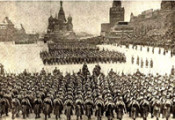
Battle for Moscow beginning
The main strategic goal of Fascist armies in autumn of 1941 was to occupy Moscow. ‘Typhoon’ operation plan approved by Hitler in September stipulated not only occupation of USSR capital but also its complete destruction along with the entire population.
On September 30, 1941 started Moscow strategic defensive operation that became the first stage of struggle under Moscow (September 30, 1941 – April 20, 1942).
The forces and resources of the Soviet commandment were quite less considerable that those of the enemy. The Western front (general I.S. Konev), Reserve front (marshal S.M. Budyonny) and Bryansk front (general A.I. Eremenko) counted 95 divisions (about 850 thousand of people), 780 tanks, 545 planes and 6 800 guns and mortars.
During the general offensive of ‘Center’ group of German armies that began on September 30, 1941 a blow was struck against the armies of Bryansk front in the direction of Oryol and from South-East bypassing Bryansk. On October 2 two more alignments started the attack from the regions of Duhovshchina and Roslavl. During the first days the enemy’s offensive was successful. The Germans managed to break through the Russian defenses and to surround the Soviet armies by October 7. The German commandment was sure that now the way to Moscow is free.
The surrounded Soviet units had for two weeks deterred about 20 German divisions. During this time the defense line had been rapidly forced, reserve armies moved closer up, but Nazi continued to yearn to Moscow. The battles were taking place in no more that 80-100 km away from the capital. In the middle of October there began the evacuation of governmental establishments, industries, population. From October 20 the city was in state of siege. To strengthen the morale of the Soviet people, who were heroically fighting the Nazi invaders, and to demonstrate to the world the courage and fortitude of the defenders of the capital, the Soviet leadership decided to hold a military parade on Red Square on November 7 to commemorate the 24th anniversary of the October Revolution.
In result of bloody battles and stubborn resistance of the Soviet armies to the German invaders the offensive of Germans was stopped in November 1941. And on December 5 the Soviet troops began the counterattack defeating enemy shock alignments of ‘Center’ group and warded off the danger that threatened Moscow by throwing the enemy 100-250 km back.
The struggle under Moscow had undermined the economical, military and moral forces of Nazis, having completely ruined the German plan of ‘lightning war’. The victory of the Red Army in this battle meant the turn of military operation in favor of USSR. It had demonstrated that the Soviet commandment was ready to solve complicated strategic problems, favored the strengthening of anti-Nazi coalition and had a great influence on the further course of the Second World War.
Lit.: Битва под Москвой. Хроника, факты, люди. Кн. 1–2. М., 2001; То же [Электронный ресурс]. URL.:http://militera.lib.ru/docs/da/moscow/index.html; Бок Ф. фон. Я стоял у ворот Москвы. Военные дневники 1941–1945. М., 2006; То же [Электронный ресурс]. URL:http://militera.lib.ru/db/bock_f/index.html.
Based on the Presidential Library’s materials:
Битва под Москвой : [фрагменты кинохроники / реж. монтажа Т. И. Дьяконова]. СПб., 2010;
Battle near Moscow (September 1941-January 1942) // Memory of a Great Victory: [digital collection].

